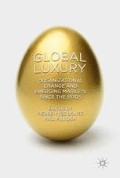Abstract
Since the end of the twentieth century, dramatic changes in global markets have affected the luxury goods industry on a worldwide scale. They have included the growing influence of emerging economies on trade, the concentration of retailing in the hands of few transnational companies, and an increasing number of mergers and acquisitions associated with the emergence of global value chains. They all called into question the traditional resources of the Italian competitiveness in fashion business and specifically in the field of personal luxury goods. This chapter analyses the specific organizational features of the Italian luxury goods industry, in order to explain how the Italian firms adapted to the new globalization and to understand whether the Italian model is still competitive at the beginning of the twenty-first century.
Access this chapter
Tax calculation will be finalised at checkout
Purchases are for personal use only
References
Bain and Company. (2015). Luxury goods worldwide market study. http://www.bain.com
Belfanti, C. M. (2008). Civiltà della Moda. Bologna: Il Mulino.
Berg, M. (2007). Luxury and pleasure in eighteenth-century Britain. Oxford/New York: Oxford University Press.
Capalbo, C. (2012). Storia della Moda a Roma. Sarti, Culture e Stili di una Capitale dal 1871 a oggi. Roma: Donzelli.
Cedrola, E., & Silchenko, K. (2016). Ermenegildo Zegna: When family values guide global expansion in the luxury industry. In J. Byoungho & E. Cedrola (Eds.), Fashion brand internationalization: Opportunities and challenges. New York: Palgrave Macmillan.
Deloitte. (2015). Global power of luxury goods. http://www.deloitte.com
Donzé, P.-Y. (2015). Global value chains and the lost competitiveness of the Japanese watch industry: An applied business history of Seiko since 1990. Asia Pacific Business Review, 21(3), 295–310.
Donzé, P.-Y., & Fujioka, R. (2015). European luxury big business and emerging Asian markets, 1960–2010. Business History, 57(6), 822–840.
Edelson, S. (1996). Flagship mania: What cost. Women’s Wear Daily Great American Design Supplement, 28, 3.
Euromonitor International. (2016). Luxury goods 2016: Key insights and system refresher. http://www.euromonitor.com
Frey, L., Livraghi, R., & Lucà Trombetta, P. (1979). Occupazione e ristrutturazioni industriali. Il caso del tessile abbigliamento. Milano: Franco Angeli.
Gereffi, G. (1999). International trade and industrial upgrading in the apparel commodity chain. Journal of International Economics, 48, 37–70.
Gereffi, G. (2014). Global value chains in a post-Washington consensus world. Review of International Political Economy, 21(1), 9–37.
ISTAT. (1954). Censimento Generale dell’Industria e del Commercio, vol. V, Industrie Tessili. Roma: Istituto centrale di statistica.
Kapferer, J. N., & Bastien, V. (2009). The luxury strategy. Break the rules of marketing to build luxury brands. London/New York: Kogan Page Publishers.
Kapferer, J. N., & Gilles, L. (2016). Where do consumers think luxury begins? A study of perceived minimum price for 21 luxury goods in 7 countries. Journal of Business Research, 69(1), 332–340.
Kapferer, J. N., & Tabatoni, O. (2013). The LVMH-Bulgari agreement: Changes in the luxury market that lead family companies to sell up. Journal of Brand Strategy, 1(4), 389–402.
Kawamura, Y. (2005). Fashion-ology: An introduction to fashion studies. New York: Berg.
Marketline. (2016). Company profile Luxottica group SpA. London: Marketline.
Merlo, E. (2008). Moda Italiana: Storia di un’Industria dall’Ottocento a oggi. Venezia: Marsilio.
Merlo, E. (2011). Italian fashion business: Achievements and challenges (1970s–2000s). Business History, 53(3), 344–362.
Merlo, E. (2012). The ascendance of the Italian fashion brands (1970–2000). In L. Segreto, H. Bonin, A. K. Kozminski, & C. Manera (Eds.), European business and brand building. Brussels: PIE Peter Lang.
Merlo, E. (2015). “Size revolution”. The industrial foundations of the Italian clothing business. Business History, 57(6), 919–941.
OECD. (2007). Moving up the value chain: Staying competitive in the global economy. Paris: OECD.
Paris, I. (2006). Oggetti Cuciti. L’Abbigliamento Pronto in Italia dal Primo Dopoguerra agli Anni Settanta. Milano: Franco Angeli.
Pent Fornengo, G. (1978). L’industria italiana dell’abbigliamento. Bologna: Il Mulino.
Pent Fornengo, G. (1992). Product differentiation and process innovation in the Italian clothing industry. In G. von Liemt (Ed.), Industry on the move: Causes and consequences of international relocation in the manufacturing industry. Geneva: International Labour Office.
Pinchera, V. (2009). La Moda in Italia e in Toscana: dalle Origini alla Globalizzazione. Venezia: Marsilio.
Rabellotti, R. (2007). Globalization, industrial districts and value chains. In M. Tsuji, E. Giovannetti, & M. Kagami (Eds.), Industrial agglomeration and new technologies. A global perspective. Cheltenham/Northampton: Elgar.
Socha, M., & Kaplan, D. (1996). Designed for cash, not just for flash. Daily News Record, 26(180), 1.
Vergani, G. (1992). Sala Bianca: Nascita della Moda Italiana. Milano: Electa.
Acknowledgement
I am grateful to Catia Brilli for the translation of this chapter.
Author information
Authors and Affiliations
Editor information
Editors and Affiliations
Rights and permissions
Copyright information
© 2018 The Author(s)
About this chapter
Cite this chapter
Merlo, E. (2018). Italian Luxury Goods Industry on the Move: SMEs and Global Value Chains. In: Donzé, PY., Fujioka, R. (eds) Global Luxury. Palgrave, Singapore. https://doi.org/10.1007/978-981-10-5236-1_3
Download citation
DOI: https://doi.org/10.1007/978-981-10-5236-1_3
Published:
Publisher Name: Palgrave, Singapore
Print ISBN: 978-981-10-5235-4
Online ISBN: 978-981-10-5236-1
eBook Packages: Business and ManagementBusiness and Management (R0)

